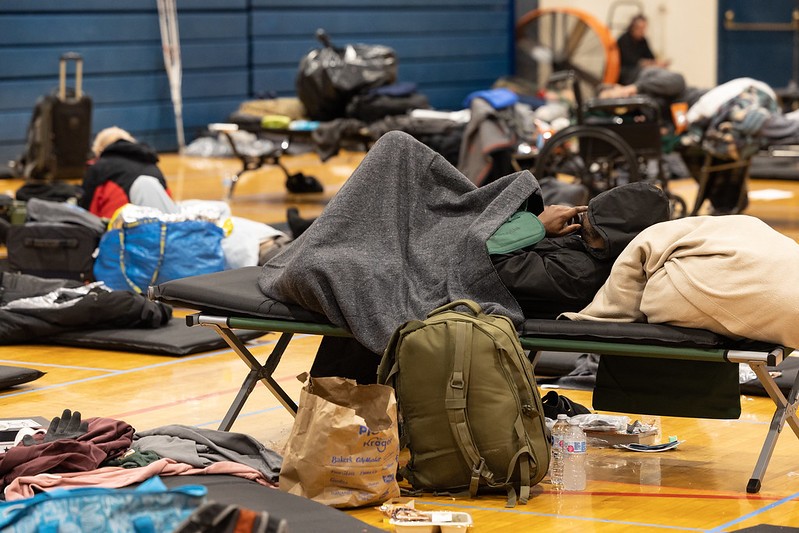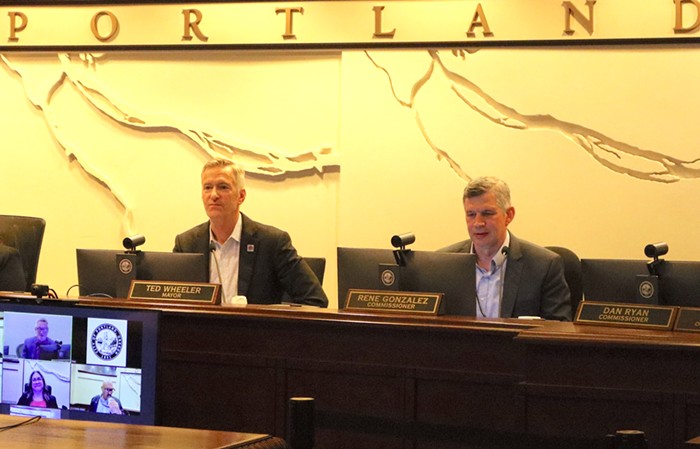During the many extreme weather events the Portland area has faced over the last several years, from heat domes to snowstorms, Multnomah County’s emergency weather shelters have been a lifeline for the area’s housing insecure population.
In late February, when the region was blanketed in snow, the county and the City of Portland opened and operated seven shelters over the course of five days—providing hundreds of people with warmth, shelter, and sustenance.
“The goal is to save people’s lives, and I think because of the numbers that we’re seeing and the cold temperatures we’re seeing, we’ve been successful in that sense,” Rachel Pearl, deputy director of the Department of County Human Services, said.
But with climate change making severe weather events more common and the area’s housing crisis increasing the number of people who need support, the operation of the shelters is taking an increasing toll on county and city officials and budgets, as well as the community volunteers whose labor the region relies on to run the shelters.
“We know long-term we need to explore what other options we have and we’re working those out right now,” Shad Ahmed, director of the Portland Bureau of Emergency Management (PBEM) said. “We’re going to have that conversation of what that looks like going forward.”
The county has opened warming shelters on at least ten days during six of the last seven winters, but the duration of those events is getting longer. The necessity of opening shelters during the summer, meanwhile, is a relatively new phenomenon. The first time the county opened a cooling shelter during the summer was just two years ago, when extreme heat claimed 72 lives in Multnomah County. The county opened three emergency cooling shelters for five days in June 2021 as temperatures hit a record-high 116 degrees.
Pearl said the county is bracing for the likelihood of more heat and wildfire smoke-related emergencies in the near future, making the operation of emergency shelters a necessity in multiple seasons.
The work of staffing the shelters is extensive, particularly when the shelters have to be open for multiple days in a row or, in the case of the last snowstorm, are open all day instead of just overnight. During the last storm, 499 different people filled 1,141 shifts at severe weather shelters—with 55 more people filling 180 shifts to provide transportation for people to get to the shelters.
The staffing challenge has been exacerbated, Pearl said, by the fact that some of the contracted providers the county has worked with in the past are facing staffing shortages of their own in the wake of the COVID-19 pandemic.
The shelters are staffed by a mix of county and City of Portland employees, contracted providers, temp workers, State of Oregon employees, and, often, volunteers who sometimes lack the training to manage spaces where people are often struggling with the effects of homelessness, mental illness, and an array of other challenges.
Many of the county employees who work at the shelters aren’t required to do so, though they do receive overtime pay for their efforts. City employees are similarly offered pay incentives to sign up for shifts. For the general public, the process of signing up for shifts can be chaotic.
“It’s remarkable that it’s been done as well as it has,” Pearl said.
Phil Barber, who has volunteered for overnight shifts at shelters during a number of severe weather events, said staff are at times overwhelmed by the level of need they encounter.
“We don’t bring enough people, we don’t bring enough skills in terms of medical or behavioral health support, we don’t bring enough supplies, and we don’t bring enough infrastructure,” Barber said.
It’s not just the more extreme weather that is increasing the strain on the county and its partners. It’s also that the area’s unhoused population continues to increase, meaning the shelters must prepare to serve increasing numbers of people during each severe weather event.
On the night of January 26, 2022, 6,633 people were living without a home in the three counties that comprise the Portland metro area—5,228 of whom were living in Multnomah County. The number of people without permanent housing in Multnomah County that night represented an increase of more than 1,300 people since the previous single-night count of the area’s homeless population taken in 2019.
The effect has been evident to the people running severe weather shelters all winter long. More than 1,000 people utilized a shelter on one night during a pre-Christmas snowstorm in December, while more than 800 people stayed in a shelter on one night during the most recent storm.
Sarah Dean, the health communications coordinator and spokesperson at Multnomah County, wrote in a message to the Mercury this has been the busiest winter season for severe weather shelters the county has ever recorded—and some of those people would like to see them open more than they already are.
For Pearl, whatever the climate concerns, housing is the number one issue when it comes to increasing emergency shelter needs.
“I think all of us feel strongly that we need more permanent housing for people who live outside—that emergency sheltering is not a solution to houselessness,” Pearl said. “We want to continue to focus the energy on that conversation… because when you have to urgently set up a shelter, there’s always limitations to that.”
Leaders at both the city and state level are in agreement that housing is a central concern. During her first week in office, Gov. Tina Kotek called the housing crises a “humanitarian disaster” and signed executive orders establishing a homelessness state of emergency in certain parts of the state, directing state agencies to prioritize reducing homelessness, and creating a new housing council. Portland City Council has also pledged to support efforts to build 20,000 new housing units in the city over the next decade.
Portland’s latest plan to address homelessness in the city, however, is to move unhoused residents into six mass outdoor camps—the first of which is expected to open this summer. While camp residents will be provided with cold weather supplies, it’s unclear how the camp administrators will respond to extreme weather events.
“That’s [the] number one, most important to prevent this need from increasing—spaces for people to be inside year-round,” Pearl said. “That is the number one prevention [method] for the need for extreme weather sheltering from increasing.”
In the meantime, the county and city are preparing to commit more resources to the joint operation of severe weather shelters with the effects of climate change making more weather-related emergencies likely in the years ahead.
Pearl said the county is putting an increased emphasis on training people to staff shelters, reviewing its signup processes, and reaching out to community members to try to find people who might want to be involved in the staffing process on an ongoing basis.
The city council, for its part, recently made funds available to PBEM to hire two full-time emergency management coordinators to take on much of the work of preparing to run emergency weather shelters.
Given current trends, the city and county governments may have to continue committing more resources to the shelter effort. Dean wrote that in addition to staffing and contractor costs, 40,000 items are required to stand up just one shelter—with the government providing everything from food to dry clothing to cots, mats, blankets, and hygiene products.
Ultimately, no amount of funding for the shelters is likely to address fundamental issues that are making them an increasingly common presence: the housing crisis and climate change. In the meantime, however, the shelters need support to continue operating.
“In a time where it often feels more and more hopeless, and people feel more and more disempowered and disconnected, this is a really hard… [thing] that people can do not only to show up for each other,” Barber said, “but show up for each other in a way that makes it impossible to forget or hide or tell a different story about what is happening on our streets.”




















